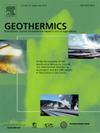Heat flow, lithospheric thermal structure, and its tectonic implication of the Southern North China Basin, East-central China
IF 3.5
2区 工程技术
Q3 ENERGY & FUELS
引用次数: 0
Abstract
Heat flow is a fundamental parameter in geothermal research. It not only complements seismic data by providing significant constraints on lithospheric thickness, geophysical properties, and tectonic evolution, but it is also vital for the evaluation and selection of geothermal resource sites. In this study, we conducted systematic measurements of steady-state temperature, thermal conductivity, and heat production from ten boreholes in the Southern North China Basin (SNCB), East-central China. These measurements yielded ten high-quality heat flow values. Combining these new data with previous research, we developed 2D temperature models and calculated lithospheric thickness. Our results reveal that heat flow in the SNCB follows a "lower in the north, higher in the south" pattern, with an average geothermal gradient of 25±5 °C/km and an average heat flow value of 57±12 mW/m². The lithospheric thickness varies significantly across the region, being approximately 105 km in the northwestern margin of the basin, increasing to 140–150 km in the eastern Huaibei Uplift, and decreasing to around 83 km in the neighboring Lower Yangtze Craton. This study not only provides geodynamic insights into variations in the thermal state of cratonic regions but also offers critical data to enhance our understanding of lithospheric structure, tectono-thermal evolution, and geothermal resource potential in the SNCB and adjacent areas.
华北盆地南缘热流、岩石圈热结构及其构造意义
热流是地热研究中的一个基本参数。它不仅通过提供对岩石圈厚度、地球物理性质和构造演化的重要约束来补充地震数据,而且对地热资源点的评价和选择也至关重要。在这项研究中,我们对中国中东部华南盆地(SNCB)的10个钻孔进行了稳态温度、导热系数和产热量的系统测量。这些测量产生了十个高质量的热流值。将这些新数据与先前的研究相结合,我们建立了二维温度模型并计算了岩石圈厚度。结果表明,SNCB热流呈现“北低南高”的格局,平均地温梯度为25±5°C/km,平均热流值为57±12 mW/m²。区域内岩石圈厚度差异显著,盆地西北缘约为105 km,淮北隆起东部增大至140 ~ 150 km,邻近的下扬子克拉通减小至83 km左右。该研究不仅为克拉通区热状态变化提供了地球动力学视角,而且为加强对SNCB及邻区岩石圈结构、构造-热演化和地热资源潜力的认识提供了关键数据。
本文章由计算机程序翻译,如有差异,请以英文原文为准。
求助全文
约1分钟内获得全文
求助全文
来源期刊

Geothermics
工程技术-地球科学综合
CiteScore
7.70
自引率
15.40%
发文量
237
审稿时长
4.5 months
期刊介绍:
Geothermics is an international journal devoted to the research and development of geothermal energy. The International Board of Editors of Geothermics, which comprises specialists in the various aspects of geothermal resources, exploration and development, guarantees the balanced, comprehensive view of scientific and technological developments in this promising energy field.
It promulgates the state of the art and science of geothermal energy, its exploration and exploitation through a regular exchange of information from all parts of the world. The journal publishes articles dealing with the theory, exploration techniques and all aspects of the utilization of geothermal resources. Geothermics serves as the scientific house, or exchange medium, through which the growing community of geothermal specialists can provide and receive information.
 求助内容:
求助内容: 应助结果提醒方式:
应助结果提醒方式:


